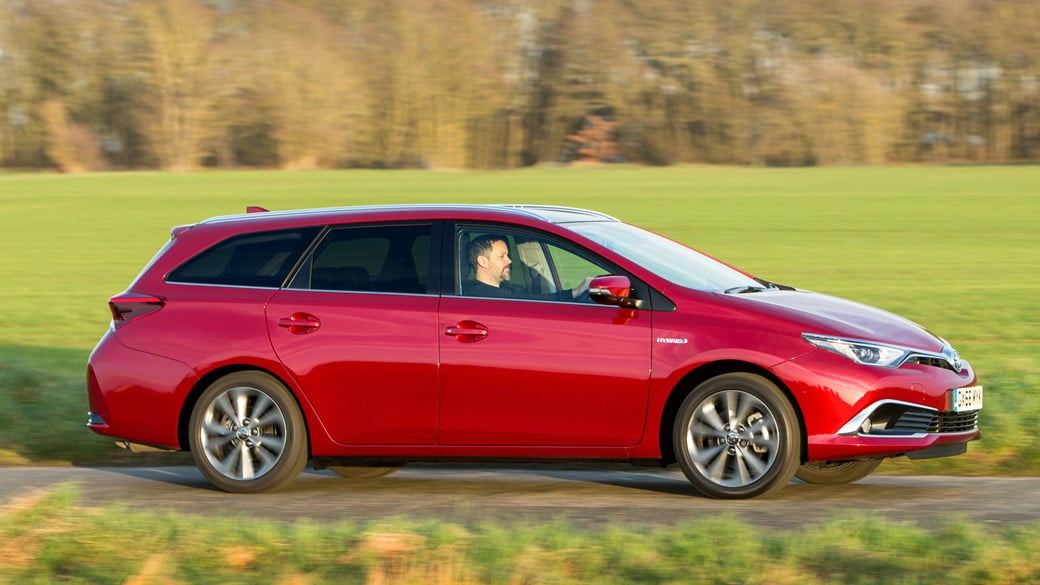
Is this the most boring car in the world you can buy right now? Quite possibly. Say the words ‘Toyota’, ‘Auris’, ‘Hybrid’ and ‘estate’ in a row and you’ll have to be admitted to hospital for sudden-onset narcolepsy. It’ll make you so devoid of excitement that it should come with a warning for you not to operate heavy machinery after driving it.
But those four words will mean a lot to someone looking for a useful and hassle-free tool. The fact that it’s an estate will appeal to those with a lot to carry and its hybrid powertrain should, on paper at least, mean infrequent trips to your local forecourt. All of this is superficial, though, so read on for our full UK review.
The car we tested was a Toyota Auris Hybrid Touring Sports in top-of-the-range Excel spec, priced at £26,095.
Is the Auris estate really that boring?
Is the Pope really a Catholic? You’re unlikely to buy a car like this if you’re interested in cars. Despite the front-end refresh in 2015, the overall design looks rather anonymous. If, for example, you took the Toyota badges off and parked it next to the starkly-designed Prius or C-HR, you’d struggle to see the family link. Modern Toyotas have become a whole lot more interesting and we suspect the next Auris will inject more interest.
Our car pictured was an Excel model finished in Tokyo Red – arguably one of the more interesting colours – but you’d want a Design model for some extra visual pep. That adds sharper black alloy wheels that help enhance the Auris’s pointy face.
What about inside the Toyota Auris Hybrid Touring Sports?
It’s still boring, despite the swooping dashboard being beset with all kinds of angles, corners and shapes. Toyota’s classic alarm clock still features, and will probably still accurately tell you the time long after a nuclear apocalypse.

In fact, most of the interior feels like it’ll take on a hard life with little fuss. Despite a wide array of materials used, most feel robust to the touch and all of the buttons and switches you’ll be regularly pressing have a pleasingly solid feel to them.
Toyota’s Touch with Go 2 infotainment system is straightforward to use and has a clear display. It does bog down a bit and take a while to load screens now and then, though, and when we tested it the Bluetooth phone link paired our mobile fine for calls but a technological hitch meant it didn’t want to play music despite numerous attempts to get it to connect properly.
What is the 2017 Auris like to drive?
Bland. It moves and stops with little fuss, the steering is decently weighted and the hybrid powertrain ensures that it’s quiet on the move in an urban environment. In EV mode, all you’ll hear is a slight whistle from the electric motor and when you come to a complete stop the car whines like a dog whose favourite bone has been thrown in the bin.

In Excel trim, those large wheels make the ride unsettled and throws up a fair bit of tyre noise at motorway speeds; the peace you get driving one through city streets quickly goes away when you venture out of town.
So, that hybrid powertrain – is it worth it?
That depends on your driving style and what you’ll be using it for. The EV mode is great for whizzing you up to speed at traffic lights and gives you a warm smug feeling when you’re sat in traffic, moving silently and using no fuel.
However, the car doesn’t like to stay in EV mode for very long and if you feather your throttle inputs to keep it using battery power alone, you’ll have some irritated drivers behind you wondering why you’re accelerating so slowly.
There’s a ‘B’ mode on the stubby clamshell gear selector which, like the Prius, amps up the brake regeneration system. When you let off the accelerator in ‘D’ the car coasts and gently slows down like any other car but when ‘B’ is engaged, letting off the throttle acts as if you’ve also gently pressed the brakes. It’s a little weird at first but it ensures you maximise the use of the battery pack by keeping it charged.

But this is the Toyota Auris estate, remember; a car that’s designed for family life and will most likely have to take more than a few trips out of town on long-distance trips with a full load. After some long motorway drives, we were averaging 53mpg cruising at regular motorway speeds – a decent chunk away from the claimed 70.6mpg figure.
When in town, there were only slight gains in economy. In order to keep up with traffic you need regular heavy pedal presses, resulting in the gruff petrol jumping into life and becoming vocal. You also have what feels like an agonising wait for the Auris to get up to speed; its claimed 11.2-secoond 0-62mph sprint feels a tad optimistic.
Is it practical though?
Oh absolutely – this is the whole reason why you’d buy a booted Auris. The boot with the seats up has a deeply impressive 672 litres of space, which is more than you get in a Renault Megane Sport Tourer, a Hyundai i30 Tourerand Ford Focus Estate.
With the seats flat, that space swells to a massive 1658 litres, which is huge for this class of estate car. Make no mistake: the Auris wagon is very versatile indeed.
Verdict
No matter how you look at it, the Auris Hybrid Touring Sports is not an exciting car to drive, sit in or even look at. It’s hard to see those of us who love cars and love driving recommending one ahead of more interesting alternatives. Its hybrid status gives it a clever technological edge that’s very on trend in an age when diesel’s dirty; just remember that the petrol-electric efficiency claims are rarely borne out in real-world driving.
The perfect buyer for this car would be someone looking for something that requires little effort, lots of interior space and a solid reliability record. Or, in fact, someone who just isn’t interested in driving.
It’s not a bad car at all. But it might be worth having an energy drink or some caffeine pills before you jump in. We wouldn’t want you to fall asleep at the wheel, would we?
[“Source-carmagazine”]






